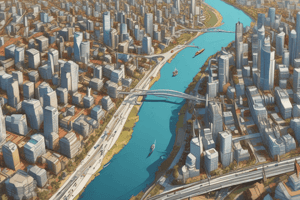Podcast
Questions and Answers
What was the influential book that explored the complex social and political landscape of Los Angeles?
What was the influential book that explored the complex social and political landscape of Los Angeles?
- City of Quartz (correct)
- Fortress LA: A City Divided
- The Urban Landscape
- The City of Angels
What was the primary influence on the urban planning of Los Angeles during its early days?
What was the primary influence on the urban planning of Los Angeles during its early days?
- The Spanish colonial tradition (correct)
- The British urban planning model
- The French urban design approach
- The American colonial tradition
What is a key characteristic of the urban redevelopment projects in Fortress L.A.?
What is a key characteristic of the urban redevelopment projects in Fortress L.A.?
- Collaborative efforts between public and private sectors
- Publicly funded and focused on low-income communities
- Privately funded and large-scale (correct)
- Focused on preserving historic landmarks
What is a characteristic of the 'Fortress LA' concept in urban planning?
What is a characteristic of the 'Fortress LA' concept in urban planning?
What is a consequence of the urban renewal projects in Fortress L.A.?
What is a consequence of the urban renewal projects in Fortress L.A.?
When did the term 'Fortress LA' emerge in the context of urban planning?
When did the term 'Fortress LA' emerge in the context of urban planning?
What is a challenge posed by the urban planning in Fortress L.A.?
What is a challenge posed by the urban planning in Fortress L.A.?
What was the original character of Los Angeles when it was founded in 1781?
What was the original character of Los Angeles when it was founded in 1781?
What is a proposed solution to the urban planning challenges in Fortress L.A.?
What is a proposed solution to the urban planning challenges in Fortress L.A.?
What is a characteristic of the affluent areas in Fortress L.A.?
What is a characteristic of the affluent areas in Fortress L.A.?
What was the consequence of the city's growth in the 19th century, particularly after the arrival of the railroad?
What was the consequence of the city's growth in the 19th century, particularly after the arrival of the railroad?
What is the outcome of the urban planning challenges in Fortress L.A.?
What is the outcome of the urban planning challenges in Fortress L.A.?
Flashcards are hidden until you start studying
Study Notes
Fortress L.A. - City of Quartz: Urban Planning in Los Angeles
Los Angeles, California, is often referred to as "Fortress L.A." due to its unique urban planning and development. This term gained popularity through the influential book "City of Quartz" by Mike Davis, which explored the city's complex social and political landscape. In this article, we focus on the urban planning aspects of Fortress L.A., discussing its history, key features, and the challenges it presents.
Historical Background
Los Angeles was originally a Hispanic town, founded in 1781 by the Spanish. Its urban planning was influenced by the Spanish colonial tradition, which emphasized the importance of the central plaza, or "plaza mayor," as a gathering place and symbol of civic pride. The city's growth in the 19th century, particularly after the arrival of the railroad, led to a change in its urban planning.
The Fortress L.A. Concept
The term "Fortress L.A." emerged in the late 20th century, reflecting the city's transformation into a fortified, corporate citadel. This concept is characterized by the clustering of development, particularly in the downtown area, and the creation of segregated, privately funded spaces that cater to the wealthy. These spaces are often protected by high security measures, creating a physical and social divide between the privileged and the marginalized.
Key Features of Fortress L.A.
One of the most striking features of Fortress L.A. is its large-scale, privately funded urban redevelopment projects. These projects, such as the renovation of the Century Plaza, have transformed the city's skyline and reshaped its urban fabric. Another key feature is the presence of publicly subsidized urban renewal projects, which have led to gentrification and the displacement of low-income residents.
Urban Planning Challenges
Fortress L.A. poses several challenges for urban planning. One of the most significant is the issue of social and economic segregation. The city's wealthier residents live in heavily fortified, privately funded enclaves, while lower-income communities are often subjected to inadequate housing and limited access to public services.
Another challenge is the lack of green spaces and public amenities in many areas of the city. This has led to a growing disparity between the affluent areas, which are often equipped with parks and other public facilities, and the less privileged neighborhoods, which lack these essential resources.
The Future of Fortress L.A.
The future of Fortress L.A. is uncertain. While some argue that the city's urban planning should focus on creating more inclusive, mixed-income communities, others believe that the city's unique character lies in its segregated, privately funded spaces. As the city continues to grow and evolve, the challenges posed by its urban planning will remain a critical issue for policymakers, urban planners, and residents alike.
Conclusion
Fortress L.A. represents a fascinating case study in urban planning, demonstrating both the potential for large-scale, privately funded redevelopment and the challenges that such development can pose. As the city continues to grapple with issues of segregation, inequality, and limited public resources, the concept of Fortress L.A. will remain a topic of ongoing debate and concern.
Studying That Suits You
Use AI to generate personalized quizzes and flashcards to suit your learning preferences.




